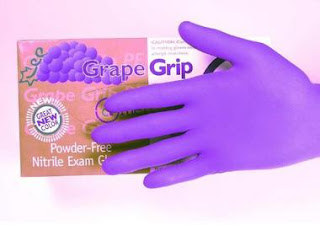It is difficult for me to get excited about a humble disposable glove, but I need to share a new model that inspired me to make a post about this glove model. It is so versatile and unique in many ways that it makes them superior to any disposable glove that we currently carry or one that I have tested in years at GO GLOVES®.
The manufacturer, PIP, brands it as: Ambi-Dex Grippaz® Engage Superior Ambidextrous Nitrile Glove with Textured Fish Scale Grip – 7 mil
PIP Product Code: 67-307
We refer to is as product code: D-307
Sizing: Small to XXXL
They did a great job on the product name, but I need to characterize and define the many features and benefits with this Ambi-Dex Grippaz® model. I truly don’t want to bore you but I need to address the various features and benefits individually since they deserve to be addressed individually.
- It has a patented, what they refer to as a “fish scale” design on the inside and outside of the glove which provides extra traction with oily or wet parts. This unique feature is much better than your typical “textured” disposable glove and this feature is not only on both sides of the glove but also on the inside which adds to the grip.
- They refer to the texture as “fish scale” but I believe a better term would be “Traction Grip Non-Slip Design”.
- It has a “rotated” thumb grip for secure precision grip of small parts. What they actually mean by this claim is, in fact, another unique attribute. The textured “fish-scale” feature is on the inside (lateral) of the thumb which mean it is located where it counts. I was initially puzzled when I read the claim since these are manufactured on a porcelain mold. I’m well aware of how these gloves are made since I manufactured disposable gloves back in 1989. PIP’s engineers deserve some kudos on this simple but unique manufacturing feature.
- 100% nitrile provides resistance to many chemicals used in industrial applications. This claim is particularly important for most of you who do not know about the various polymers or rubber used in disposable gloves. First and foremost is that these are latex-free which are prone to allergic reactions and all latex models immediately deteriorate in the presence of any oil or petroleum substance. Today, Nitrile is the premier material of choice in most disposable, waterproof, and chemical resistant gloves.
- Made with a specially formulated organic compound that gives excellent performance with all food types including “fatty” foods. This is a particularly important element for gloves used in food preparation and processing.
- Amplified dexterity for enhanced comfort, mobility, and less hand fatigue.
- Increased puncture resistance outlasts conventional disposables which helps reduce glove waste and glove costs.
- 7 Mil thickness – This thickness equates to a higher strength glove which is less likely to rip when putting them on. Typical high-use disposable gloves are normally around 4 to 5 Mil but again these are a higher-quality glove. I should point out that most people do not feel the difference in gloves ranging between 4 to 7 Mil but a little bit more means a lot more in this case.
- Better fit than traditional household gloves. This seems like a trivial fact but you will notice this feature the moment you put on a pair.
- Form-fitting beaded cuff can be worn over a glove liner.
- Touch Screen Friendly. A funny note on this is that I often see people automatically remove their disposable gloves when answering or texting on their cell phones and many people do not realize that most disposable gloves are also touch screen friendly. I bet most of you never realized this. <smile>
- Powder-Free to reduce allergic reactions. On this issue as I have mentioned in previous posts, the trend today is moving to powder-free gloves in general and even the FDA has banned the use of powdered gloves in 2016 for use in the healthcare industry. Plus, powdered gloves are more expensive.
- Complies with FDA food handling requirements 21 CFR 177.2600.
- AQL Testing: 1.5 < This test standard is the “Acceptable Quality Limit” based on the testing of large production runs which tests for any and all glove defects. An AQL test of 1.5 is equal to that with medical exam gloves, so these gloves have a great threshold which means you are buying a very high-quality glove.
- These gloves are ideal for both men and women and the come in sizes from Small to XXXL for men with exceptionally large hands. On sizing, I brought home a pair for my wife to test since she wears gloves daily when washing the dishes and doing household chores. Being particular about the gloves she wears, she has since ditched the gloves she has used for years and has switched to these due to the fit, the dexterity, the thinness, and the nice grip feature without having to use a thicker and bulkier textured waterproof glove.
- The new Orange Color is another plus since it provides for enhanced eye-to-hand visual sharpness and acuity.
In conclusion, I am happy to introduce you to these unique disposable gloves and please feel free to email me if any of you have any questions about these or any other glove issues. I also hope some of you found this post helpful and useful.
Link: D-307 Ambi-Dex Grippaz Nitrile Glove
Link: Disposable Gloves
Thank you for subscribing,
Joe McGarry
The Glove Guru
GO GLOVES®












